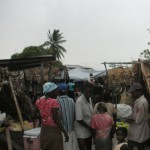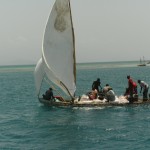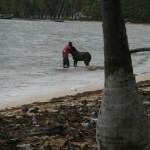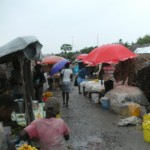Ile a Vache, Haiti
There are 36 small villages on the offshore island of Ile a Vache, Haiti, surrounded by some of Haiti’s better reefs. In early dawn light a breathtaking scene that is centuries old unfolds: the ocean is covered to the distant horizon with scores of sailing boats headed for island and offshore waters. There are no motors in this fleet. Small canoes made from single, huge mango trunks and larger handmade craft which hoist latteen rigs swiftly carry fishers to their day’s work.
The nets of 1 inch mesh and long lines and sheer numbers of fishers mean large fish are gone. A typical catch consists of juveniles, restocking from the deep, and only between 4-6 inches in length. The villages of Ile a Vache have no power, no roads, no cars and local open well water. We anchored in the Baie A’Feret, just offshore of the village of Caille Coq. Sounds of the day carried out to Llyr: the slam of dominoes on tabletops; shouts from boys and men playing soccer games; the voices of children headed to and from school…. As darkness falls, everything quietens down. The flicker of cell phone flashlights that gained their charge from solar charging stations dotted around town can be seen wavering along the beach. Off in one far corner of town a bar-shack with a generator sometimes plays music.
On the tip of this bay is the Port Morgan Hotel where a shiny burgundy helicopter comes and goes ferrying, we are told, friends of the president and supplies for their pleasure from the capital Port au Prince. Their guards are hardened men with old, well polished shotguns.
We spread our huge and torn Universal Power Sail out by the helicopter where the ground was open and flat and traded it to two fishermen – we cut it fully in two – for lobster, potatoes, onions, carrots and mangoes. The helicopter guard with his shotgun was a friendly translator between Creole and English.
The walk to the island’s bi-weekly market, and to Sister Flora’s well known orphanage, was 7 miles by path in light rain and slick, caking clay mud. We passed through tidy thatched fishing compounds, large fields being plowed with hand swung maddox, and swamp flats of disturbing filth, garbage and odors.
The market was intense. Dense crowds packed into narrow alleys of thick, slick mud, filthy puddles hemmed by palm frond and plastic-covered stick frames sheltering charcoal fires, frying dough, fish, fish traps, vegetables and plantains, toiletries, candies and shoes from the mainland. On the other side of the market, past dozens of pack donkeys with palm/rattan packs, we arrived at L’Oeuvre St Francois, the orphanage and school run by Sister Flora Blanchette,a French Canadian who has spent the last 35 years on the island. She is a small powerhouse, clear and political. We listened to her forceful emphasis on a need for jobs and that nonprofits are not helpful with this. It comes down to economics, she stressed. People don’t need charity; they need to earn their living in meaningful and sustainable ways. Sister Flora is well aware that the fisheries are in trouble. She spoke of her vision of bringing pistachio farming to the area, a crop with strong intrinsic artisanal value that keeps and transports well. She asserted that pushing Ile a Vache to tourism only drives up prices for the poorest and excludes them while destroying village integrity. She told us she was glad for the rain to fill the water cisterns, but concerned because cholera thrives in rain and the cooler temperatures it brings. In December, she lost 6 children to cholera.
Before leaving Ile a Vache for Providencia, Colombia we took a public launch six miles to shore to Les Cayes, Haiti’s third largest city. Winds were strong on a lee shore so surf was pounding the landing area where all boats came to town: not a dock, but smashed cement chunks and rocky shoreline crowded by side to side shacks with cement privy’s set out over the water. Stirred by driving wind the surf was a grey and brown froth of garbage and human waste. On shore waste piled high, a yard of rotting material underfoot. Lateen rigged sailboats, packed with mango baskets crowded in and dropped rebar hooks to grab the bottom. Lean old men, soaked, legs spread wide standing with long poles deftly maneuvered their smaller craft to our boat to ferry us closer to shore. They poled us to the edge of the surf where other younger men waded out to us in chest-deep water and directed us to climb on their backs. They brought all of us to shore in this fashion and for their services, everyone got a little money. An older woman, in her blue, go-to-market dress attempted her own transition from a sailboat loaded with mango baskets. She lost her footing and went underwater into the sewage. She came up, and waded ashore, revealing all in her sudden transition from elegant to undone.
We were in town to get groceries and bottled water. To get them back to the boat, we hired a young man with a cart. This consisted of a truck axle topped with planks and pull-poles. The town was buzzing with scooters, cars and pedestrian traffic. He hoisted up the loaded cart and charged off to the docks, wearing old rubber flip flops with no heels.
The following comments were written by Janis
Situated in the western end of the southern coast, Les Cayes is Haiti’s third largest city. Greg had a scheduled appointment with some UN officials and needed to be delivered to town. Les Cayes has an exposed shoreline, bearing the full effect of the E/SE tradewinds and swell. There is no harbor or safe docking area. We brought Llyr in as close as we dared and then Connor drove Greg, EJ and Romain to shore in the tender. We quickly realized that we had no interest in turning circles for the morning in all that swell with shallow sand banks all around us. We decided to head on over to our next destination, Ile a Vache, an island about 5 miles away, uncertain as to how exactly we’d recover the shore team. (Fortunately, they were able to get a water taxi over later that morning.)
Entering Baie A’Ferret, we were quickly surrounded by small canoes. People were hanging off our freeboard (Llyr’s side walls) before we’d had a chance to set our anchor! In cruising literature, Ile a Vache is the only recommended stop on Haiti’s southern coast. Most sailors typically bypass Haiti altogether, however, the few that do stop come to this small, sheltered bay. The impact of this modest amount of activity was very visible to us. People clearly understood that sailing boats represented economic opportunity and during our stay there, we had many daily visitors offering services like hull washing, laundry, prepared meals, and more. Sadly, we also had many people straight-out begging. Llyr had arrived in the last weeks of school, and among our visitors were many young men hoping to earn some money to pay for their final exams. Families have to pay for everything for their children to go to school in Haiti – from pencils to uniforms to tuition and exams.
The island of Ile a Vache is home to several dozen small communities, most of which depend upon subsistence fishing and farming. There are few options for earning money. Our Reef Check surveys found some of the healthiest reefs yet and with the already present “tourism” in the area, it seemed Ile a Vache would be selected as a potential site for an MPA. There were already plans underway to open a small museum on the island with artifacts from shipwrecks as part of encouraging more tourism, and dive tourism in particular.
As elsewhere in Haiti, establishing an MPA in Ile a Vache would be a daunting task. Our interest was to listen and think aboutways to develop alternatives that might help make it possible. Based on our observations and what we discussed with Sister Flora, Ile a Vache would need a lot of careful planning in order to set the groundwork for an MPA and tourism alone clearly isn’t the answer. Tourism was already breeding some ill feelings in the community as it was perceived as benefiting only a few. We were very impressed with Sister Flora’s assessments of the problems and her vision of the possibilities.
(I was also most interested in Sister Flora’s opinion that it was a good thing that families had to pay for their children’s schooling and supplies. She felt that if these came for free, they would have no value and families would not push their children so hard at school. I don’t know enough about the education situation in Haiti to know exactly what I think of this perspective. I can say that with an average family size of 6 children on Ile a Vache, I’m not sure that all the children get an equal shot, particularly the girls. During our whole time there, I was never approached by a teenage girl asking for help with her exams, whereas this was a common occurrence with the young men. While this isn’t conclusive evidence, it certainly fits worldwide trends.)
Caille Coq was the first place Gavin got to play with any kids this summer. Three young boys–Levins, Michelin, and Israel–became regular visitors to Llyr and would sometimes take Gavin back to shore to play soccer with them. After Gavin’s first soccer game in town, he came back with huge blisters on the soles of his feet from running around barefoot on the dry dusty field. Of course, none of the boys had shoes, let alone cleats and shin guards. At first, the boys asked for money for being Gavin’s “friend” and we told them that it was not right to pay them for friendship We did, however, hire them for small jobs like carrying our garbage to shore. At the end of our visit, we shared a lunch with them and gave them some school supplies.
Our work with Reef Check came to an end in Ile a Vache and we said goodbye to Greg, EJ and Romain. We really enjoyed having them aboard Llyr, making it possible for us to visit Haiti and learn more about Reef Check (Connor and Rowan became excellent at data entry!) and just enjoy their great company. We shared some delicious feasts, adventure, starry nights and close quarters.
When they left, we felt the loss of EJ and Romain’s Creole, but by that time, we had a “fixer” to help us with any necessary tasks. Carma Cadet was a local from Caille Coq with pretty good English. Between that and my French, we were fairly well set for the remainder of our time in the area. Carma helped us get water, he accompanied us to Madame Bernard to the market and to the orphanage, and traveled with us to Les Cayes for reprovisioning before our next passage. Our conversations with Carma were great and he gave us some real insight into life on Ile a Vache. We shared stories with him about our farm and discussed our purpose and interests on this expedition. He sat through our conversation with Sister Flora and from that we had many interesting discussions about economic opportunity.
Les Cayes
In order to reprovision for our next passage, we would have to make a trip to the city of Les Cayes. Brooks and I left Connor, Rowan and Gavin with Llyr and were joined by Carma for the 45 minute ride by water taxi to the mainland. The water taxis are 20 ft open,narrow boats with 40 hp outboard motors. Passengers can sit three abreast.
As soon as we came out of Baie A’Ferret, we hit the waves and the ride to shore was wild. As we got near the town, the waters were so turbulent that we were met by smaller boats that could bring us closer to shore. Trying not to get dumped, we clambered from one boat to the next as they heaved side by side. These smaller boats were operated by wiry old men who poled the boats closer to shore. When these also could not make a landing, we were met by young men who walked out waist deep in the swell and they piggy-backed us to shore! The shoreline was just a gap in the line of housing that stuck out over the water. The ground was covered in litter and other human waste. Carma quickly led us into the streets of Les Cayes so that we could do our shopping
Les Cayes has featured prominently in national and international news since the earthquake in 2010. Briefly, shortly after the earthquake, there was a riot in the prison in which many prisoners were killed and wounded. Initial reports claimed that it was prisoners who had killed other prisoners, but evidence began to mount that this was not the case. This January, almost two years after the slaughter, a 3 month trial concluded finding 8 prison officials guilty. In a rare occurrence, the highest ranking officials – the former Les Cayes prison warden and the city’s riot police chief, who was tried in absentia – were given the stiffest sentences. This trial was hailed as a landmark case in Haiti, where corrupt officials are not often punished. For many people it is a hopeful sign that some things are changing in this strife-torn country.
You can read more about this amazing story at the following link.
http://www.nytimes.com/2012/01/20/world/americas/7-haitian-policemen-convicted-in-2011-les-cayes-prison-killings.html?pagewanted=all
We finished our shopping and then stopped in a local restaurant for lunch to wait for our return launch to Ile a Vache. Carma found the young man with the cart and worn flip flops who hauled our groceries and water bottles back to the boat. The seas had not calmed down. We watched the wild shoreside scene as we waited for our piggy-back rides back out to the poling boat, and from there to the water taxi. The return trip had us into the wind and waves so we all covered ourselves with plastic tarp and sat in darkness all the way back to Ile a Vache
Time was coming for us to leave Haiti. This would be our first offshore passage with just our family on board. Our access to weather forecasts was spotty as the only source for internet was at the hotel and they were having trouble getting on line, but the weather reports we were able to obtain indicated favorable winds and seas for our passage south. We decided that we’d head for Providencia, Colombia, an island well off the coast of Nicaragua. We figured it would take us about 4 days to get there, leaving another 2 day passage to Panama.
Below is the link to the New York Times Haitian EcoDivers Video
http://video.nytimes.com/video/2011/09/01/world/americas/100000001030590/ruin-and-hope-on-haitis-reefs.html
Additionally, this is a link to a New York Times video raising concerns about USAID policy in Haiti and highlighting the tensions about economic development in Haiti and conservation of biological and cultural resources.
http://video.nytimes.com/video/2012/07/05/world/americas/100000001632553/a-factory-grows-in-haiti.html















